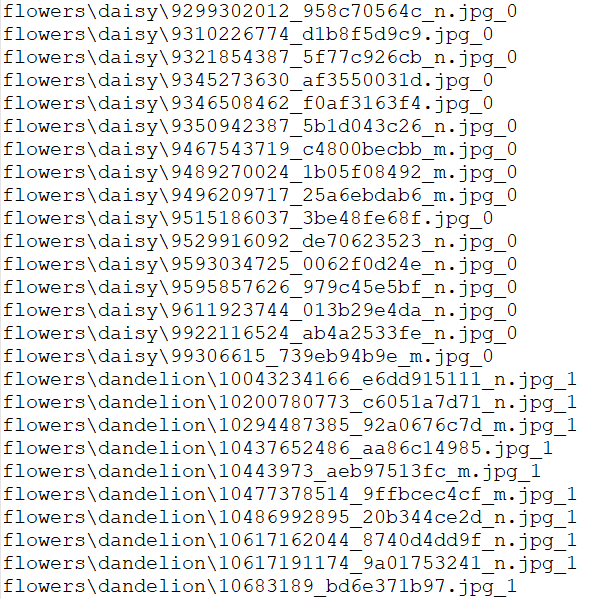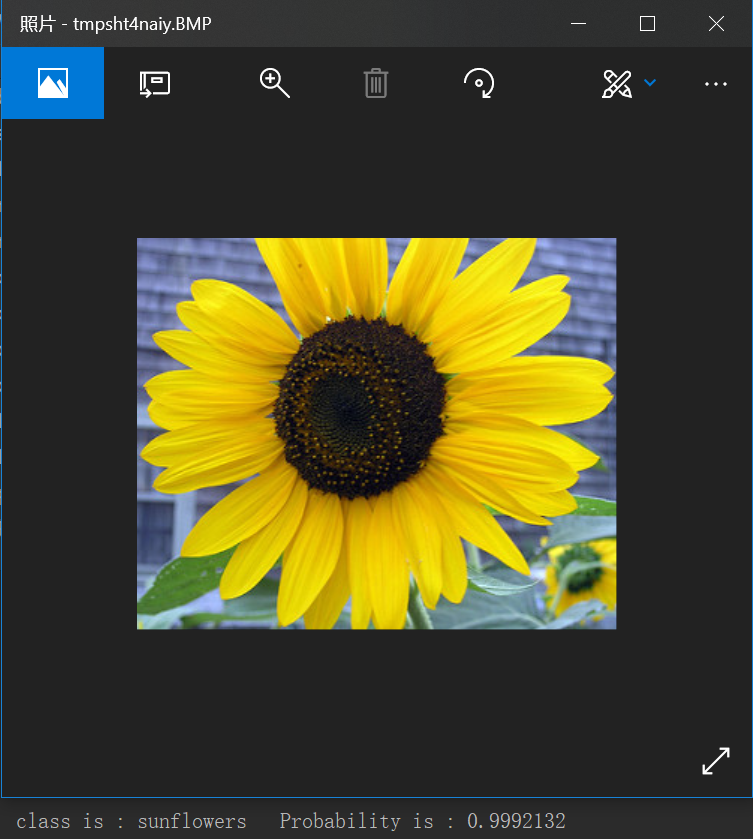使用TensorFlow给花朵🌺分类
第一步:准备好需要的库
- tensorflow-gpu 1.8.0
- opencv-python 3.3.1
- numpy
- skimage
- os
- pillow
第二步:准备数据集:
链接:https://pan.baidu.com/s/1Kbz_UaRhAfhlweFY28R8Sw 密码:iym3
本次使用了花朵分类的数据集,总共有5类

每类里面有不同形态的同一类花朵

在下载完数据集之后,我们对数据集进行预处理:
from skimage import io, transform
import os
import numpy as np # 将所有的图片resize成100*100
w = 100
h = 100
c = 3 # 读取图片
def read_img(path):
imgs = []
labels = []
classs = os.listdir(path) for idx, folder in enumerate(classs):
cate = os.path.join(path, folder)
for im in os.listdir(cate):
img_path =os.path.join(cate, im)
# print('reading the images:%s' % (img_path))
img = io.imread(img_path)
img = transform.resize(img, (w, h))
# with open('tests.txt', 'a') as f:
# f.write(img_path+'_'+str(idx)+'\n')
imgs.append(img)
labels.append(idx)
return np.asarray(imgs, np.float32), np.asarray(labels, np.int32) def suffer(data, label):
# 打乱顺序
num_example = data.shape[0]
arr = np.arange(num_example)
np.random.shuffle(arr)
data = data[arr]
label = label[arr] # 将所有数据分为训练集和验证集
ratio = 0.8
s = np.int(num_example * ratio)
x_train = data[:s]
y_train = label[:s]
x_val = data[s:]
y_val = label[s:]
return x_train,y_train,x_val,y_val def minibatches(inputs=None, targets=None, batch_size=None, shuffle=False):
assert len(inputs) == len(targets)
if shuffle:
indices = np.arange(len(inputs))
np.random.shuffle(indices)
for start_idx in range(0, len(inputs) - batch_size + 1, batch_size):
if shuffle:
excerpt = indices[start_idx:start_idx + batch_size]
else:
excerpt = slice(start_idx, start_idx + batch_size)
yield inputs[excerpt], targets[excerpt]
我们将图片统一设为100×100的大小,然后对每一个文件夹标号,作为标签。为了检验我们是否将标签与图片对齐,我预留了一个写文件路径+标签的一个文件。
写出来是这样的

在做处理好标签和图片之后我们将其设定为 np.asarray(imgs, np.float32)的格式。
然后将这些图片随机打乱顺序。以8:2的比例划分训练集和验证集。
接着我们来生成minibatch:将数据切分成batch_size的大小送入网络。
在预处理完数据之后,我们开始进行网络的构建
import tensorflow as tf def batch_norm(x, momentum=0.9, epsilon=1e-5, train=True, name='bn'):
return tf.layers.batch_normalization(x,
momentum=momentum,
epsilon=epsilon,
scale=True,
training=train,
name=name) def simple_cnn(x):
# 第一个卷积层(100——>50)
conv1 = tf.layers.conv2d(
inputs=x,
filters=32,
kernel_size=[3, 3],
padding="same",
activation=tf.nn.relu,
kernel_initializer=tf.truncated_normal_initializer(stddev=0.01))
conv1 = batch_norm(conv1, name='pw_bn1')
pool1 = tf.layers.max_pooling2d(inputs=conv1, pool_size=[2, 2], strides=2) # 第二个卷积层(50->25)
conv2 = tf.layers.conv2d(
inputs=pool1,
filters=64,
kernel_size=[3, 3],
padding="same",
activation=tf.nn.relu,
kernel_initializer=tf.truncated_normal_initializer(stddev=0.01))
conv2 = batch_norm(conv2, name='pw_bn2')
pool2 = tf.layers.max_pooling2d(inputs=conv2, pool_size=[2, 2], strides=2) # 第三个卷积层(25->12)
conv3 = tf.layers.conv2d(
inputs=pool2,
filters=128,
kernel_size=[3, 3],
padding="same",
activation=tf.nn.relu,
kernel_initializer=tf.truncated_normal_initializer(stddev=0.01))
conv3 = batch_norm(conv3, name='pw_bn3') pool3 = tf.layers.max_pooling2d(inputs=conv3, pool_size=[2, 2], strides=2) # 第四个卷积层(12->6)
conv4 = tf.layers.conv2d(
inputs=pool3,
filters=128,
kernel_size=[3, 3],
padding="same",
activation=tf.nn.relu,
kernel_initializer=tf.truncated_normal_initializer(stddev=0.01))
conv4 = batch_norm(conv4, name='pw_bn4') pool4 = tf.layers.max_pooling2d(inputs=conv4, pool_size=[2, 2], strides=2) re1 = tf.reshape(pool4, [-1, 6 * 6 * 128]) # 全连接层
dense1 = tf.layers.dense(inputs=re1,
units=1024,
activation=tf.nn.relu,
kernel_initializer=tf.truncated_normal_initializer(stddev=0.01),
kernel_regularizer=tf.contrib.layers.l2_regularizer(0.003))
dense2 = tf.layers.dense(inputs=dense1,
units=512,
activation=tf.nn.relu,
kernel_initializer=tf.truncated_normal_initializer(stddev=0.01),
kernel_regularizer=tf.contrib.layers.l2_regularizer(0.003))
logits = tf.layers.dense(inputs=dense2,
units=5,
activation=None,
kernel_initializer=tf.truncated_normal_initializer(stddev=0.01),
kernel_regularizer=tf.contrib.layers.l2_regularizer(0.003))
pred = tf.nn.softmax(logits, name='prob')
return logits, pred
我们的网络由4个卷积层,两个全连接层,一个softmax层组成。在每一层的卷积后面加入了batch_normalization,relu和池化。
batch_normalization层很好用,加上它之后,有效的预防了梯度消逝和爆炸,还加速了收敛。
在搭建好网络之后,我们开始编写训练模块
import tensorflow as tf
import cnn
import dataset
# 将所有的图片resize成100*100
w = 100
h = 100
c = 3
path = 'flowers' x = tf.placeholder(tf.float32, shape=[None, w, h, c], name='x')
y_ = tf.placeholder(tf.int32, shape=[None, ], name='y_') logits,pred = cnn.simple_cnn(x)
loss = tf.losses.sparse_softmax_cross_entropy(labels=y_, logits=logits)
train_op = tf.train.AdamOptimizer(learning_rate=0.001).minimize(loss)
correct_prediction = tf.equal(tf.cast(tf.argmax(logits, 1), tf.int32), y_)
acc = tf.reduce_mean(tf.cast(correct_prediction, tf.float32)) data, label = dataset.read_img(path)
x_train, y_train,x_val, y_val = dataset.suffer(data, label) # 训练和测试数据,可将n_epoch设置更大一些
n_epoch = 11
batch_size = 16
def train():
sess = tf.InteractiveSession()
sess.run(tf.global_variables_initializer())
saver = tf.train.Saver()
for epoch in range(n_epoch):
train_loss, train_acc, n_batch = 0, 0, 0
for x_train_a, y_train_a in dataset.minibatches(x_train, y_train, batch_size, shuffle=True):
_, err, ac = sess.run([train_op, loss, acc], feed_dict={x: x_train_a, y_: y_train_a})
train_loss += err
train_acc += ac
n_batch += 1 print('Epoch %d - train loss: %f'%(epoch, (train_loss / n_batch)))
print('Epoch %d - train acc: %f'%(epoch,train_acc / n_batch)) # validation
val_loss, val_acc, n_batch = 0, 0, 0
for x_val_a, y_val_a in dataset.minibatches(x_val, y_val, batch_size, shuffle=False):
err, ac = sess.run([loss, acc], feed_dict={x: x_val_a, y_: y_val_a})
val_loss += err
val_acc += ac
n_batch += 1
print('Epoch %d - Validation loss: %f' %(epoch, val_loss / n_batch))
print('Epoch %d - Validation Accuracy: %f'%( epoch,(val_acc / n_batch)))
if epoch % 5 == 0:
saver.save(sess, "./model/save_net.ckpt",epoch)
print('Trained Model Saved.') train()
训练时我们首先要定义X,Y作为索引
x = tf.placeholder(tf.float32, shape=[None, w, h, c], name='x')
y_ = tf.placeholder(tf.int32, shape=[None, ], name='y_') 然后对于刚才构建的网络进行损失的计算,精确度计算以及优化器的选择。
接着我们将session初始化
sess = tf.InteractiveSession()
sess.run(tf.global_variables_initializer())
saver = tf.train.Saver()
然后将定义的X,Y索引与你的真实数据,标签对齐。
使用
_, err, ac = sess.run([train_op, loss, acc], feed_dict={x: x_train_a, y_: y_train_a})
开始运行就可以了。
测试同理,不过测试的时候不需要优化器,所以只需要加入参数loss,acc就可以了。
我们每隔5次保存一次模型。
在训练结束后,我们对使用之前训练好的模型进行预测:
import numpy as np
import tensorflow as tf
from PIL import Image, ImageDraw, ImageFont
from cnn import simple_cnn
# 将所有的图片resize成100*100
w = 100
h = 100
c = 3
classes = ['daisy','dandelion','roses','sunflowers','tulips']
image_test = Image.open('44079668_34dfee3da1_n.jpg')
resized_image = image_test.resize((w, h), Image.BICUBIC)
image_data = np.array(resized_image, dtype='float32') imgs_holder = tf.placeholder(tf.float32, shape=[1, w, h, c]) logits,pred = simple_cnn(imgs_holder) saver = tf.train.Saver()
ckpt_dir = './model/' with tf.Session() as sess:
ckpt = tf.train.get_checkpoint_state(ckpt_dir)
saver.restore(sess, ckpt.model_checkpoint_path)
classes_ = sess.run(pred,feed_dict={ imgs_holder: np.reshape(image_data , [1, w, h, c])}) num = np.argmax(classes_)
print('class is :',classes[int(num)],' Probability is :',classes_[0][int(num)])
在预测时,因为子还需要输入一张图片就可以了,所以我们只制作图片的索引
imgs_holder = tf.placeholder(tf.float32, shape=[1, w, h, c]) 然后读取刚才保存的参数,只需要输入目录,即可自动读取最后训练的模型。
然后运行:
classes_ = sess.run(pred,feed_dict={ imgs_holder: np.reshape(image_data , [1, w, h, c])})
输出每个类的概率值。
我们将这个概率最大的值的标号读取出来,对应之前文件夹的标号。
classes = ['daisy','dandelion','roses','sunflowers','tulips']
然后将这个标号对应的概率数标出来。
本次使用了tf.layer进行了简单CNN的构建,并且使用了tensorflow传统的sess.run
的方法来运行图,没有使用之前提到的高级API。
在这种方法上进行了简单的尝试,接下来会尝试使用slim框架构建网络。
使用TensorFlow给花朵🌺分类的更多相关文章
- SVM原理以及Tensorflow 实现SVM分类(附代码)
1.1. SVM介绍 1.2. 工作原理 1.2.1. 几何间隔和函数间隔 1.2.2. 最大化间隔 - 1.2.2.0.0.1. \(L( {x}^*)\)对$ {x}^*$求导为0 - 1.2.2 ...
- 芝麻HTTP:TensorFlow LSTM MNIST分类
本节来介绍一下使用 RNN 的 LSTM 来做 MNIST 分类的方法,RNN 相比 CNN 来说,速度可能会慢,但可以节省更多的内存空间. 初始化 首先我们可以先初始化一些变量,如学习率.节点单元数 ...
- tensorflow实现二分类
读万卷书,不如行万里路.之前看了不少机器学习方面的书籍,但是实战很少.这次因为项目接触到tensorflow,用一个最简单的深层神经网络实现分类和回归任务. 首先说分类任务,分类任务的两个思路: 如果 ...
- tensorflow学习笔记————分类MNIST数据集
在使用tensorflow分类MNIST数据集中,最容易遇到的问题是下载MNIST样本的问题. 一般是通过使用tensorflow内置的函数进行下载和加载, from tensorflow.examp ...
- Tensorflow实现手写体分类(含dropout)
一.手写体分类 1. 数据集 import tensorflow as tf from tensorflow.examples.tutorials.mnist import input_data im ...
- 用 TensorFlow 实现 SVM 分类问题
这篇文章解释了底部链接的代码. 问题描述  如上图所示,有一些点位于单位正方形内,并做好了标记.要求找到一条线,作为分类的标准.这些点的数据在 inearly_separable_data.csv ...
- TF Boys (TensorFlow Boys ) 养成记(四):TensorFlow 简易 CIFAR10 分类网络
前面基本上把 TensorFlow 的在图像处理上的基础知识介绍完了,下面我们就用 TensorFlow 来搭建一个分类 cifar10 的神经网络. 首先准备数据: cifar10 的数据集共有 6 ...
- tensorflow 教程 文本分类 IMDB电影评论
昨天配置了tensorflow的gpu版本,今天开始简单的使用一下 主要是看了一下tensorflow的tutorial 里面的 IMDB 电影评论二分类这个教程 教程里面主要包括了一下几个内容:下载 ...
- 基于tensorflow的文本分类总结(数据集是复旦中文语料)
代码已上传到github:https://github.com/taishan1994/tensorflow-text-classification 往期精彩: 利用TfidfVectorizer进行 ...
随机推荐
- Jquery Cookie操作
// 写入 $.cookie('the_cookie','the_value');// 读取 $.cookie('the_cookie');// 删除 $.cookie('the_cookie',nu ...
- OneZero第四次站立会议(2016.3.24)
会议时间:2016年3月24日 15:30~15:47 会议成员:冉华,张敏,王巍,夏一鸣. 会议目的:汇报前一天工作,全体成员评论,确定会后修改内容. 会议内容:以下为会议插图 1.界面原型方面,在 ...
- 深入理解ajax系列第八篇——表单提交
前面的话 在以前,网站的用户与后端交互的主要方式是通过HTML表单的使用.表单的引入在1993年,由于其简单性和易用性,直到电子商务出现之前一直保持着重要位置.理解表单提交,对于更深入地理解ajax是 ...
- 06.基于IDEA+Spring+Maven搭建测试项目--dubbo-consumer.xml配置
<?xml version="1.0" encoding="UTF-8"?> <beans xmlns="http://www.sp ...
- logstash获取日志,时间戳相差8小时
背景: logstash版本:2.4.9 由于logstash在获取时区的时候,默认获取的是UTC默认时间,同时elasticsearch在创建索引的时候,统一使用UTC时间,因此实际上在创建 ...
- [USACO18OPEN]Out of Sorts G 冒泡排序理解之一
题目描述 给一个双向冒泡排序的程序: moo表示输出moo sorted = false while (not sorted): sorted = true moo to N-: ] < A[i ...
- 国内k8s集群部署的几种方式
版权声明:本文为博主原创文章,未经博主允许不得转载. https://blog.csdn.net/lusyoe/article/details/80217291前言总所周知,由于某种原因,通过官方的方 ...
- node.js浅谈
相信大家对node.js也很不陌生吧,现在我来总结一下常用的吧~ 我们Web全栈工程师最多的就是用Node作为后台了,Node.js虽然可以作为后台语言,但是相对于Java那些老牌后台语言真是一点优势 ...
- pytho部分命令
python --version查看版本号 pip install XXX 安装模块 pip uninstall XXX 卸载模块
- jQuery总结或者锋利的jQuery笔记二
第三章 jQuery 中 DOM 操作 , 进入这一章,你必须先要有 选择器的基础, 最好是基本选择器 (id,class,*,div,p 组合等) , 层次选择器(div ul),(div> ...


